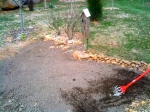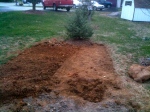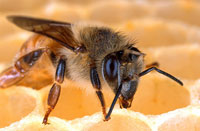With winter finally baring its frigid fangs here in central PA, even I, a lifelong proponent of colder 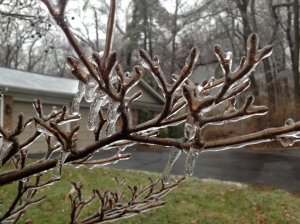 temperatures, have taken to wishing for warmer climes. But, with schoolwork and student teaching compelling me to weather at least one more icy winter here, I’ve resorted to finding (typically culinary) ways to keep the brumal blues at bay! Lately, my quest for cold-dispelling recipes has led me to finally trying dishes that I’d favorited and bookmarked over the years, but had never actually attempted. First on this list of “eventual eats” was a recipe for Chinese Tea Eggs that I discovered here nearly a year ago. Captivated by the incredible look and purported flavor of these eggs, I knew I had to give ’em a go!
temperatures, have taken to wishing for warmer climes. But, with schoolwork and student teaching compelling me to weather at least one more icy winter here, I’ve resorted to finding (typically culinary) ways to keep the brumal blues at bay! Lately, my quest for cold-dispelling recipes has led me to finally trying dishes that I’d favorited and bookmarked over the years, but had never actually attempted. First on this list of “eventual eats” was a recipe for Chinese Tea Eggs that I discovered here nearly a year ago. Captivated by the incredible look and purported flavor of these eggs, I knew I had to give ’em a go!
While the tea eggs are extremely easy to make, do ensure that you have enough time to allow the eggs to fully absorb the color/flavor of the tea! I made the mistake of starting my batch rather late at night, so the eggs I ended up with were a tad lighter than the traditional tea egg. However, even though the coloring was a bit pale, the flavor of the eggs was powerful and peculiarly delicious! Plus, as an added bonus, the tea and spices infused the kitchen with an incredible chai-like aroma while the eggs were steeping!
Chinese Tea Eggs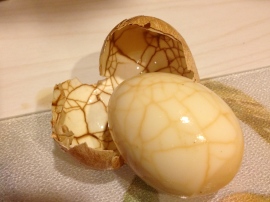
Cooking time: Approximately 2 hours
Ingredients
6 eggs
4 black tea bags, or 2 tablespoons of loose black tea leaves
2 teaspoons of Chinese five spice
1 tablespoon coarse salt
(Optional) Toasted sesame seeds
Instructions
1. Place eggs in a large pot and fill with enough cold water to cover the eggs. 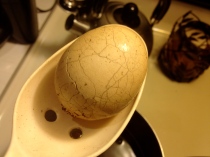
2. Bring water to a boil over medium heat and let simmer for 12 minutes.
3. Remove the eggs from the water, and with a spoon, tap the eggs until the shells are covered with cracks.
4. Return the eggs to the pot of water and gently stir in the tea, Chinese five spice, and salt.
5. Cover the pot, heat gently, and let simmer for one hour.
6. Remove the pot from the heat and leave the eggs to cool in the liquid for 30 minutes.
7. Take one egg from the liquid, and peel to determine whether your eggs are dark enough, or if they need to remain in the liquid longer.
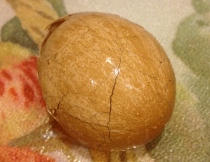 8. When you’re satisfied with the color of your eggs, remove the whole batch from the water and allow to cool fully.
8. When you’re satisfied with the color of your eggs, remove the whole batch from the water and allow to cool fully.
9. With your eggs completely cooled, peel each egg (taking time to admire the fascinating coloration of the shells), and enjoy! You may also wish to garnish your eggs with toasted sesame seeds before serving.
Without a doubt, the process of creating a clutch of Chinese Tea Eggs wholly served to keep my mind off of the near sub-zero temperatures outside! I can only hope that they’ll do the same for you!
Until next time, happy cooking, gardening, and doing whatever else brings you joy!



